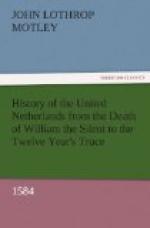The beggared archbishop, more forlorn than ever since the death of his great patron, cried woe from his resting-place in Delft, upon Protestant Germany. His tones seemed almost prophetic of the thirty years’ wrath to blaze forth in the next generation. “Courage is wanting to the people throughout Germany,” he wrote to William Lewis of Nassau. “We are becoming the laughing-stock of the nations. Make sheep of yourselves, and the wolf will eat you. We shall find our destruction in our immoderate desire for peace. Spain is making a Papistical league in Germany. Therefore is Assonleville despatched thither, and that’s the reason why our trash of priests are so insolent in the empire. ’Tis astonishing how they are triumphing on all sides. God will smite them. Thou dear God! What are our evangelists about in Germany? Asleep on both ears. ‘Dormiunt in utramque aurem’. I doubt they will be suddenly enough awakened one day, and the cry will be, ‘Who’d have thought it?’ Then they will be for getting oil for the lamp, for shutting the stable-door when the steed is stolen,” and so on, with a string of homely proverbs worthy of Sancho Panza, or landgrave William of Hesse.
In truth, one of the most painful features is the general aspect of affairs was the coldness of the German Protestants towards the Netherlands. The enmity between Lutherans and Calvinists was almost as fatal as that between Protestants and Papists. There was even a talk, at a little later period, of excluding those of the “reformed” church from the benefits of the peace of Passau. The princes had got the Augsburg confession and the abbey-lands into the bargain; the peasants had got the Augsburg confession without the abbey-lands, and were to believe exactly what their masters believed. This was the German-Lutheran sixteenth-century idea of religious freedom. Neither prince nor peasant stirred in behalf of the struggling Christians in the United Provinces, battling, year after year, knee-deep in blood, amid blazing cities and inundated fields, breast to breast with the yellow jerkined pikemen of Spain and Italy, with the axe and the faggot and the rack of the Holy Inquisition distinctly visible behind them. Such were the realities which occupied the Netherlanders in those days, not watery beams of theological moonshine, fantastical catechism-making, intermingled with scenes of riot and wantonness, which drove old John of Nassau half frantic; with banquetting and guzzling, drinking and devouring, with unchristian flaunting and wastefulness of apparel, with extravagant and wanton dancing, and other lewd abominations; all which, the firm old reformer prophesied, would lead to the destruction of Germany.
For the mass, slow moving but apparently irresistible, of Spanish and papistical absolutism was gradually closing over Christendom. The Netherlands were the wedge by which alone the solid bulk could be riven asunder. It was the cause of German, of French, of English liberty, for which the Provinces were contending. It was not surprising that they were bitter, getting nothing in their hour of distress from the land of Luther but dogmas and Augsburg catechisms instead of money and gunpowder, and seeing German reiters galloping daily to reinforce the army of Parma in exchange for Spanish ducats.




